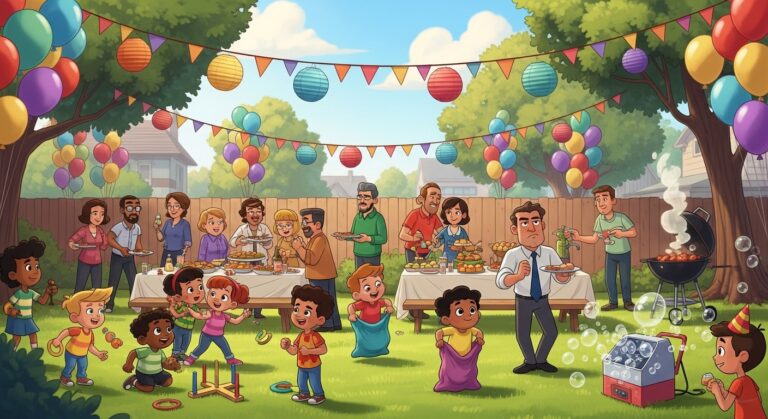It was a sunny Saturday afternoon when I found myself engaged in a lively conversation with my neighbor, Bill. We stood on the edge of my backyard, surrounded by the scent of freshly mowed grass and the distant sounds of children’s laughter. Bill had recently moved into the neighborhood, and we had only gotten to know each other over the past year. As we chatted about the pressure washing service he had used to rejuvenate the exterior of his home, my attention was drawn to his kids, who were joyfully playing soccer in the cul-de-sac.
Suddenly, the cheerful ambiance broke as I heard a yelp. Bill’s youngest child had fallen and scraped her knee, her cries piercing the peaceful afternoon. As Bill rushed to comfort her, I felt a wave of empathy wash over me. After all, I had been the neighborhood’s resident for over fifteen years; I had seen countless children grow up and play in the same streets.
Once the situation was under control, our conversation resumed. Bill shared a troubling concern: he was contemplating putting up a fence in his backyard. When I inquired about the reasoning behind this decision, he sighed deeply, explaining that his other neighbor, Alex, had a reputation for being rather intolerant of children’s playful antics. Apparently, Alex had taken it upon himself to enforce a strict boundary around his property, which, given that none of the houses were fenced, seemed rather absurd.
“Alex doesn’t just yell at the kids for playing too close,” Bill elaborated, shaking his head in disbelief. “He gets upset if they even step onto his grass! Can you believe it?”
I chuckled, imagining an adult getting riled up over a few innocent children running around. “So, what’s the plan? A fortress to protect your kids from the wrath of Alex?” I teased.
Bill responded with a wry smile, “Something like that. But it’s not just about the fence. I want my kids to have a place to play without worrying about stepping on someone’s lawn or hitting a ball into a neighbor’s property.”
As we discussed the pros and cons of having a fence, I couldn’t help but feel a sense of solidarity with Bill. His situation resonated with me; I had witnessed the gradual decline of carefree outdoor play in our neighborhood due to the rising tensions between neighbors. Children should be able to play freely without fear of reprimand.
In a moment of inspiration, I proposed an alternative: “What if we create a community space? A designated area where kids can play, and everyone is welcome? We could even host family-friendly events to foster a sense of unity in the neighborhood.”
Bill’s eyes lit up at the thought. “That could work! But how do we convince everyone to participate?”
“Let’s organize a block party,” I suggested. “We can invite all the neighbors, bring food, set up games for the kids, and create a space where everyone can come together. It will be a great way to break the ice!”
With that, our plans took off. We spent the following weeks rallying the neighborhood, printing flyers, and knocking on doors, inviting everyone to join our block party. Some residents were skeptical, particularly Alex, who seemed resistant to the idea of fostering a friendly environment. But others were enthusiastic, eager for an opportunity to meet each other and create a vibrant community.
The day of the block party arrived, and I could hardly contain my excitement. The air was filled with the enticing aroma of grilled burgers and hot dogs, while laughter echoed as children played games in the makeshift play area we had set up. Neighbors brought out their lawn chairs, and the atmosphere transformed into one of warmth and camaraderie.
As the sun began to set, I noticed Alex standing slightly apart, his arms crossed and a frown etched on his face. With a determined spirit, I approached him. “Hey, Alex! Why don’t you join us? The food is great, and the kids are having a blast!”
To my surprise, he hesitated before replying, “I just… don’t see the point. Kids should know their boundaries.”
I took a deep breath, choosing my words carefully. “Boundaries are important, but so is community. We want our kids to play and enjoy their childhood. It’s not about crossing lines; it’s about building connections.”
He looked thoughtful for a moment, and I could see the gears turning in his mind. “I suppose I could stick around for a little while.”
As the evening unfolded, I watched as Alex slowly warmed up to the festivities. He interacted with the other parents, shared stories, and even joined in a friendly game of tug-of-war. By the end of the night, he was laughing and joking alongside the very children he had been so quick to chastise.
When the party concluded, Bill and I stood together, surveying the joyful chaos around us. “I can’t believe how well this turned out,” he said, a smile spreading across his face.
“Right? We’ve created something special here,” I replied, feeling a sense of accomplishment. “And maybe, just maybe, we’ve opened a door for Alex to see things differently.”
In the weeks that followed, the block party transformed our neighborhood. Children played freely in the yards, and parents engaged in friendly conversations, fostering a spirit of togetherness. Even Alex began to relax, occasionally joining in the fun, his once stern demeanor softening as he learned to embrace the joy of community.
And so, the backyard revolution began—not just for Bill’s kids, but for all the children and families in our neighborhood. It was a reminder that sometimes, the smallest acts of kindness and connection can lead to the most profound changes.
As I leaned back on my porch one evening, watching the kids play and hearing the laughter that filled the air, I knew we had created something lasting. Our backyard had become more than just a space; it had become a symbol of unity, where boundaries were redefined and friendships blossomed.





0 Comments